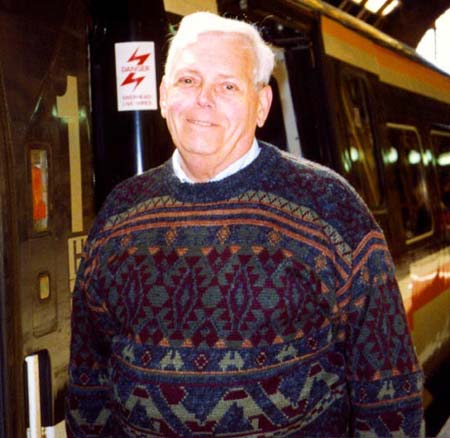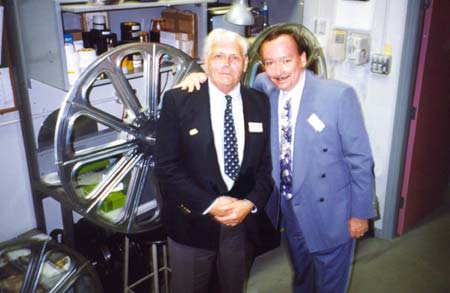|
Those familiar with the technical credits of the Cinerama travel films will recognized
the name Richard Vorisek (1918-1989). He did post-production sound mixing on those five titles. Richard's brother John (Who died January 8 this year, age 75) had an
unaccredited, but significant, involvement with the original production, "This is
Cinerama".
 John
Vorisek in 1993 in Leeds, England. Picture by
Robert Weisgerber. John
Vorisek in 1993 in Leeds, England. Picture by
Robert Weisgerber.
Richard Vorisek started work at the New York City Reeves Sound Studios in 1936. John joined his brother there in 1943, becoming the seventh member of the staff. By the time John left the
organization, in 1971, he was the president of a company with 250 on the payroll. John and his brother then formed their own postproduction sound studio;
Trans/Audio Inc, which became "Todd-AO East" when that California based sound firm decided to set up an east coast branch in 1987.
After a lifetime in sound, John always recalled that the original Cinerama sound music playback he heard, of
"This is Cinerama" score, was better than any sound recording he had ever heard - before or since. John himself played a crucial role in creating the sound effects of two important sequences in
"This is Cinerama". For some reason, no suitable location six-track recording of the opening roller-coaster ride had ever been made. He mixed standard mono sound effects mono sound effects phonograph recordings of track noises, screams, and the famous "gong", to produce the sounds that "surround" one of the most significant sequences in motion picture history.
Creating the speedboat sounds for the "Cypress Gardens" sequence was a task involving much more time, patience and effort. Again, no multi-track location recordings had been made. John worked with mono 1/4" tape "wild" sound takes. (Some sources suggest that these were made at the waters of Oyster Bay rather than Florida.). Whatever the source of the sounds, John extracted the noises of about six distinct motors, which were transferred onto six different magnetic tracks for mixing purposes. Working at the Reeves Studio, John then painstakingly viewed all three picture reels of the "Cypress Gardens" sequence individually, on a hand operated viewer. He noted the footage at which significant action occurred in each panel e.g. when boats moved in or out of the frame, skiers fall in water, etc. Using this data, he mixed a six-track magnetic "Cinerama format" recording with the sounds of various
motorboats matching their movements around the screen. To achieve the final sound-effects track, featuring motor boats, splashes, applause, whistles and other background noises, about 65 different tracks were created. The combined sound effects track was then taken to Oyster Bay where it was mixed with the music track and Lowell Thomas commentary.
|
Further in 70mm reading:
Internet link:
November 2002 update:
Hi Thomas, a correction regarding the Jack Vorisek obit. Last sentence, he
went to Bradford with a companion and the widow of his brother Dick Vorisek.
The reason I know this is that my wife and I accompanied them on the trip
(his son and wife could not make it). See attachment of photos taken on the
trip, Jack is the older man of the two. Could you correct the obit. for the
record.
Best Always, Robert Weisgerber
|
 John
Vorisek in Pictureville's projection room 1993 with Bob
Weisgerber. Picture supplied by Robert Weisgerber. John
Vorisek in Pictureville's projection room 1993 with Bob
Weisgerber. Picture supplied by Robert Weisgerber.
John was also involved with the folklore surrounding the first night of "This is Cinerama" September 30, 1952 at the Broadway Theatre. The show print consisted of sequences not finally joined together until the day before opening night. Starting at that Monday evening, John, and production assistant James Morrison, started work - back stage at the theatre - marking the reels of film with an edge numbering machine. About 2 AM on the 30th, the machine broke down. In an act of supreme hopefulness, John rang the Brooklyn manufacturer, and was flabbergasted to have his call answered by staff, who - by merest chance - had been staying late to complete inventory. About an hour later, with a new machine, John and James were able to resume their effort. By late afternoon the young men were exhausted and it was clear that the job, of numbering all eight reels, could not be completed in time for that evening's performance. John explained this to Hazard Reeves who promptly ordered them home to freshen up for the premiere. The film ran that night on the proverbial "wing and a prayer". Had the show been interrupted mid-reel, the lack of edge numbers would have prevented a
synchronized re-start. (The film of one panel did, in fact break during the end credits sequence, but the loss of image was camouflaged by the early closing of the curtains).
The next day John returned to the theatre and completed the edge numbering in time for the first regular performance. Reeves had him remain at the theatre, as company rep., for a few weeks, but after this John had no further involvement with Cinerama productions. However, he retained very fond memories of the process, and his involvement with it. He leaves a wife and son who accompanied him to Bradford in June 1993 to attend the re-launching of Wallers Wonder.
Based on John Vorisek recollections recorded May 1991 and March 1997.
|
|
 John
Vorisek in Pictureville's projection room 1993 with Bob
Weisgerber. Picture supplied by Robert Weisgerber.
John
Vorisek in Pictureville's projection room 1993 with Bob
Weisgerber. Picture supplied by Robert Weisgerber.

 John
Vorisek in 1993 in Leeds, England. Picture by
John
Vorisek in 1993 in Leeds, England. Picture by